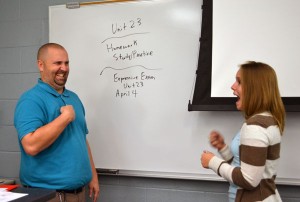
Sharon Hill, the coordinator of the ASL Interpreting Program, said she expects the program to grow in the coming years. ASL professor Terrell Brittain and Hill say that hearing students should do interpreting and leave ASL to Deaf people. There are many opportunities for hearing students, Hill said. | Aisha Bouderbaden/The Daily Cougar
UH is the only university in Texas to offer a four-year degree plan for American Sign Language Interpreting.
“Lamar University in Beaumont offers a degree in ASL but not interpreting,” said Sharon Hill, the coordinator of ASL Interpreting Program.
All the professors who teach ASLI 1 through 4 and Deaf Culture classes are Deaf, including Terrell Brittain, who has been teaching at the University since 2010. The term “Deaf” is capitalized to indicate an individual grew up exposed to Deaf Culture, whereas “deaf” indicates an individual is deaf, but did not grow up in the culture.
Brittain was interviewed about his experience with an interpreter present.
“I have that passion to teach the language,” Brittain said. “I love passing on the tradition, and I try to incorporate humor (into my teaching). This language is one we can’t afford to let become extinct.”
Brittain grew up using a system called Signing Exact English and used gestures to communicate with his hearing parents. It was not until he was 17 years old that he met another d/Deaf person.
“Later on, I married her,” Brittain said. “She was the one who really introduced me to ASL and influenced my use of ASL.”
Brittain’s wife, Robyn, started teaching ASLI at the University last fall.
He started as an adjunct professor in 2010 and became a full-time assistant professor in 2011. Now, he averages about four to five classes each semester, teaching any of the four levels of the language, Deaf Culture and advanced ASLI, which is only open to interpreting majors to increase their fluency and syntax.
“The d/Deaf community is small, compared to the hearing one,” Brittain said. “The number of years this community has suffered oppression — the list goes on and on. (The d/Deaf community has) constantly been told they can’t. Hearing people should learn that.”
Hill said the ASLI program was endorsed in Fall 2009 and explained how an interview works when hiring a d/Deaf applicant.
By law, d/Deaf individuals are not allowed to be discriminated against and have rights to an interpreter.
“It’s very easy to hire somebody who can speak and hear,” Hill said. “We wanted a master instructor, a natural user of ASL, and (Brittain) was an easy pick.”
A certified interpreter is hired to conduct the interview because not everyone on the hiring committee speaks ASL.
“Notes and lip reading are insufficient forms of communication,” Hill said. “There is an urgent need for interpreters. There are roughly 1,500 interpreters in the whole state.”
Compared to the statistic of the d/Deaf population, which is about 12 to 15 percent, that number is far too low.
“Because it is ‘silent,’ this language is often overlooked and devalued,” Hill said. “I think students are starting to appreciate the instructors.”
The style of each ASL professor is different, and Brittain said it is important for students to not stick with one professor because style varies — learning signs one way and one way only does not help a student grow in their knowledge and application of the language.
“Each individual style is different. I try to provide as much information as possible. The most important thing I want students to know is that I am responsible for teaching, but students are responsible for putting in the effort,” Brittain said. “My expectations are high. ASL is not an easy-A class, and it is always a reward at the end of ASL 4 to see how my students have progressed.”
Hill said she sees the ASLI Program going far in the years to come.
“As a famous quote from I. King Jordan states, ‘Deaf people can do anything except hear,’” Brittain said.
